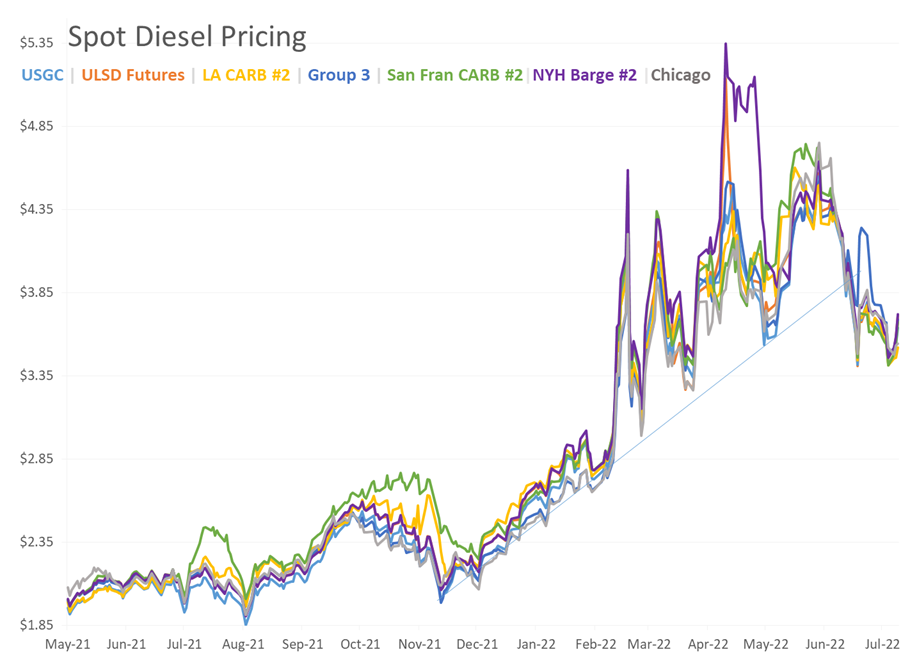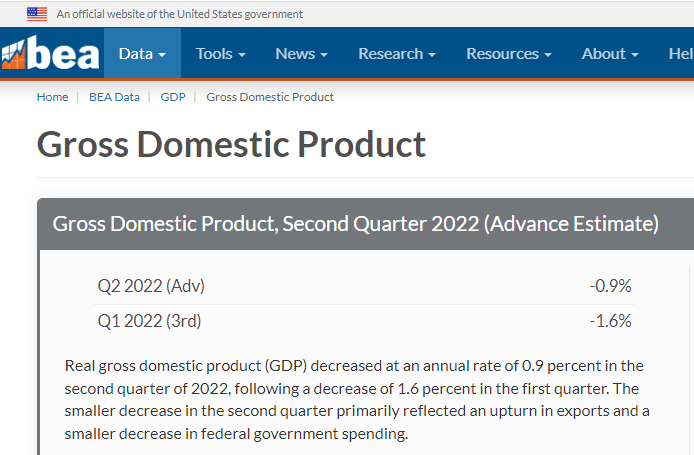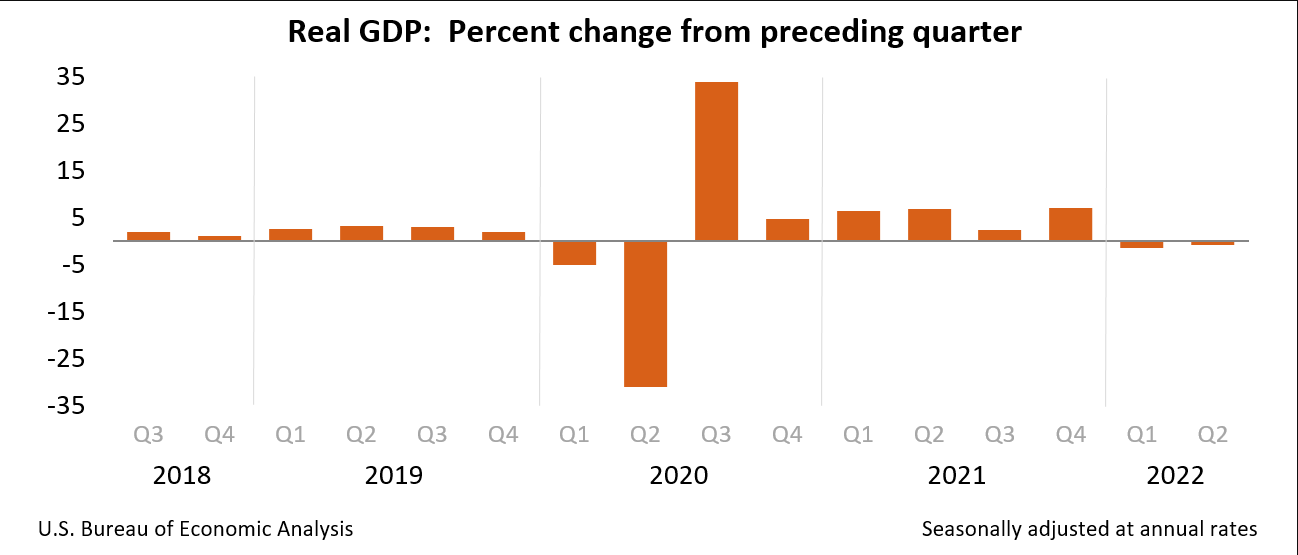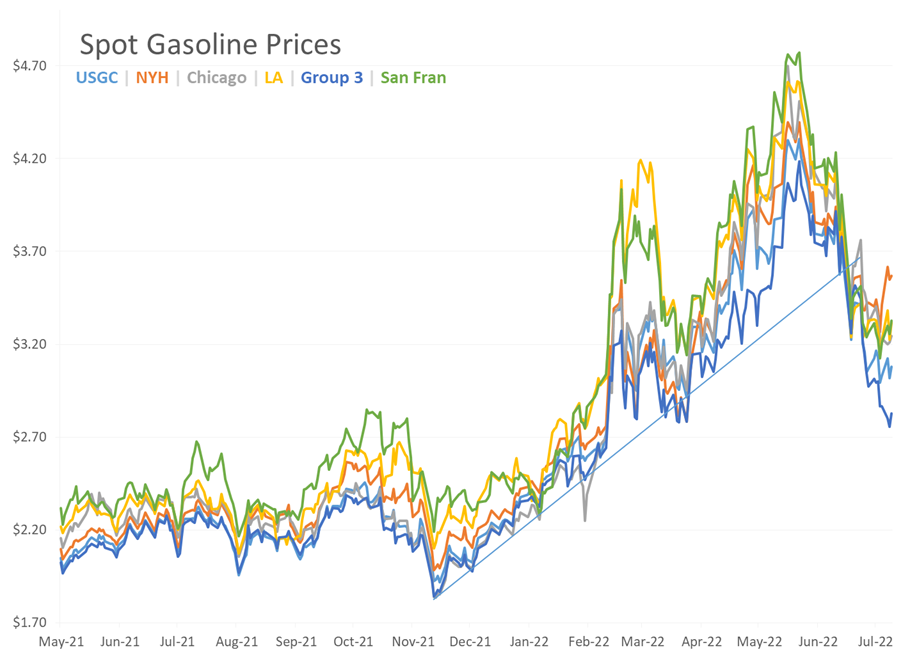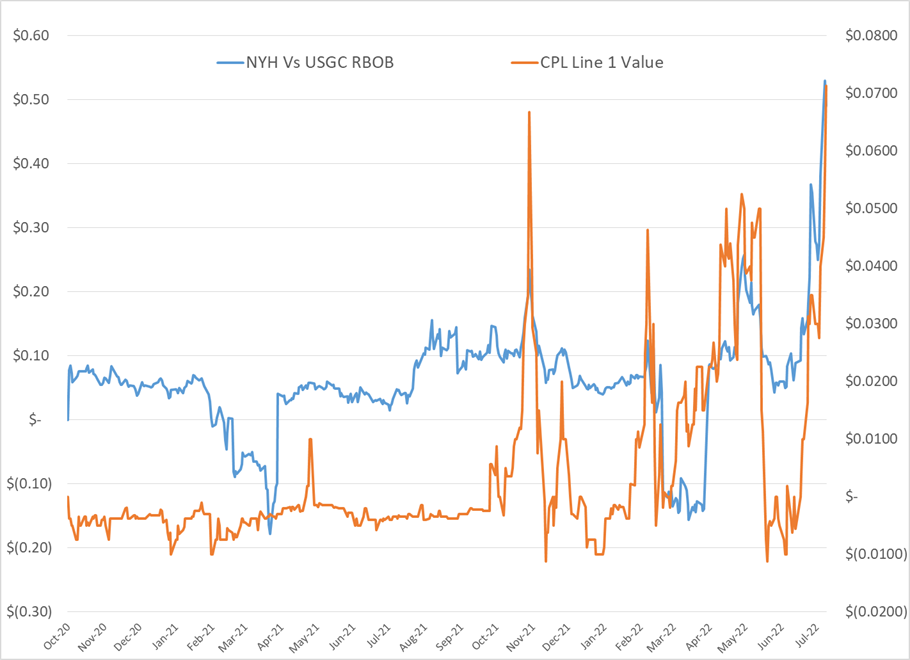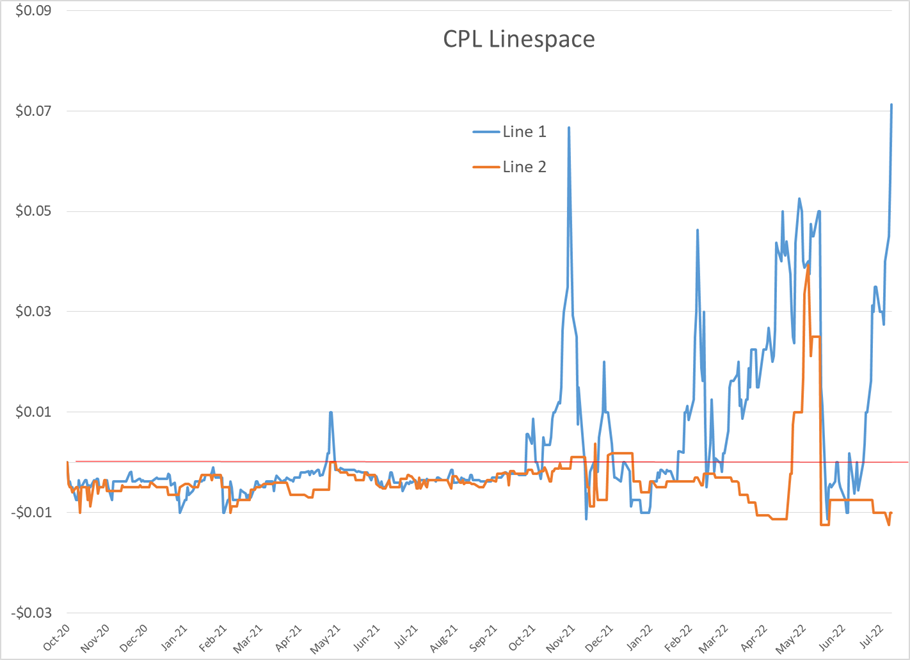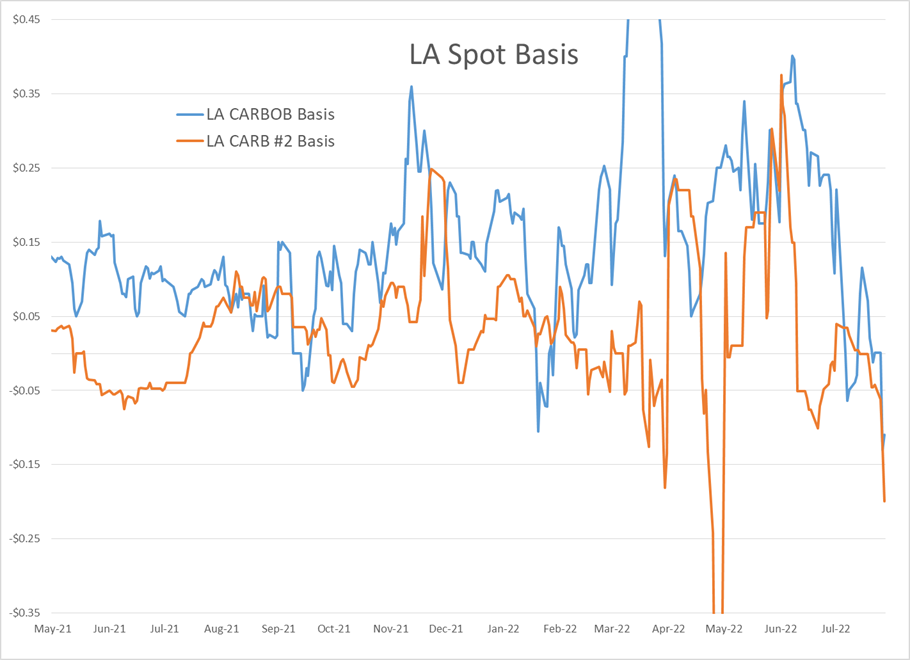Diesel Prices Are Trying To Drag The Rest Of The Energy Complex Higher This Morning

Diesel prices are trying to drag the rest of the energy complex higher this morning as their weekly rally has now surpassed 40 cents in less than 4 days. Gasoline prices are resisting the pull higher so far, despite some positive demand signals in yesterday’s DOE report, and remain range-bound for now, while WTI is facing a big test near $100.
We said yesterday morning that the ULSD contract looked like it was ready to make a run at $3.80 after breaking through resistance on the charts around $3.60 and it didn’t waste any time already reaching that mark this morning. The last time ULSD touched $3.80 3 weeks ago, it dropped 20 cents the next day, so today’s tug of war with gasoline could prove pivotal. A break and hold above $3.80 opens the door for another 40 cent run higher for diesel, while a failure sets up a drop to the lower end of the July trading range.
All sorts of news out of Washington that may influence markets as the Senate has made a surprise breakthrough on a bill that includes nearly $370 billion in energy and climate change programs, while the commerce department just reported it’s GDP estimate showing the US is now “not officially” in a recession with a 2nd straight quarter of contracting GDP.
Bad news is good news when it comes to the stock market reaction to FED policy, and it seems like the Chairman’s statement that the US economy shows signs of slowing yesterday was enough to send stocks rallying once again, as it implies that the pace of increase for interest rates is going to slow down after their largest increase in over 40 years. The big rally in stocks following that announcement seemed to spill over to the energy arena in the afternoon, but could also create more volatility if today’s confirmation of that economic slowdown sends the big money funds to the sidelines.
If you’re an energy bull, you may note that we’ve already lived through the recession, and yet yesterday’s DOE report showed a healthy recovery in fuel consumption which could mean the worst is behind us…not to mention that the world still doesn’t have a solution to replace Russian natural gas and distillate supplies.
Notes from yesterday’s DOE Report:
US crude oil exports surged to an all-time high last week north of 4.5 million barrels per day. That means a total of roughly 32 million barrels of oil (more than 1.3 billion gallons) were sent overseas last week, which makes the inventory drop of 4.5 million barrels in total for the week suddenly less impressive.
Refinery output dropped for a 2nd straight week, with 4 out of 4 PADDs declining, with the Midwest (PADD 2) leading the way with another major decline in run rates. Given the weakness in Group 3 and Chicago basis values, it doesn’t seem like anyone is worried about declining output in the middle of the country - most of which is unable to be exported – although this could spell trouble in the fall if rates don’t pick back up as Gulf Coast facilities seem to have their hands full trying to keep up with demand from Europe and the rest of the Americas.
Demand for gasoline and distillates were estimated to have climbed for a 2nd straight week putting both products back close to their seasonal 5 year averages after dropping below their seasonal range earlier in July. A big drop in gasoline imports, and the decline in refinery run rates are combining with that tick higher in demand to draw inventories lower after more than a month of gains.
The inventory declines are most pronounced on the East Coast, which helps explain why RFG gasoline in New York is worth 50 cents more per gallon today than it is in Houston, and nearly 70 cents more than its conventional counterparts in the Midwest.
See charts below.
Latest Posts
Gasoline Futures Are Leading The Way Lower This Morning
The Sell-Off Continues In Energy Markets, RBOB Gasoline Futures Are Now Down Nearly 13 Cents In The Past Two Days
Week 15 - US DOE Inventory Recap
Prices To Lease Space On Colonial’s Main Gasoline Line Continue To Rally This Week
Social Media
News & Views
View All
Gasoline Futures Are Leading The Way Lower This Morning
It was a volatile night for markets around the world as Israel reportedly launched a direct strike against Iran. Many global markets, from equities to currencies to commodities saw big swings as traders initially braced for the worst, then reversed course rapidly once Iran indicated that it was not planning to retaliate. Refined products spiked following the initial reports, with ULSD futures up 11 cents and RBOB up 7 at their highest, only to reverse to losses this morning. Equities saw similar moves in reverse overnight as a flight to safety trade soon gave way to a sigh of relief recovery.
Gasoline futures are leading the way lower this morning, adding to the argument that we may have seen the spring peak in prices a week ago, unless some actual disruption pops up in the coming weeks. The longer term up-trend is still intact and sets a near-term target to the downside roughly 9 cents below current values. ULSD meanwhile is just a nickel away from setting new lows for the year, which would open up a technical trap door for prices to slide another 30 cents as we move towards summer.
A Reuters report this morning suggests that the EPA is ready to announce another temporary waiver of smog-prevention rules that will allow E15 sales this summer as political winds continue to prove stronger than any legitimate environmental agenda. RIN prices had stabilized around 45 cents/RIN for D4 and D6 credits this week and are already trading a penny lower following this report.
Delek’s Big Spring refinery reported maintenance on an FCC unit that would require 3 days of work. That facility, along with several others across TX, have had numerous issues ever since the deep freeze events in 2021 and 2024 did widespread damage. Meanwhile, overnight storms across the Midwest caused at least one terminal to be knocked offline in the St. Louis area, but so far no refinery upsets have been reported.
Meanwhile, in Russia: Refiners are apparently installing anti-drone nets to protect their facilities since apparently their sling shots stopped working.
Click here to download a PDF of today's TACenergy Market Talk.

The Sell-Off Continues In Energy Markets, RBOB Gasoline Futures Are Now Down Nearly 13 Cents In The Past Two Days
The sell-off continues in energy markets. RBOB gasoline futures are now down nearly 13 cents in the past two days, and have fallen 16 cents from a week ago, leading to questions about whether or not we’ve seen the seasonal peak in gasoline prices. ULSD futures are also coming under heavy selling pressure, dropping 15 cents so far this week and are trading at their lowest level since January 3rd.
The drop on the weekly chart certainly takes away the upside momentum for gasoline that still favored a run at the $3 mark just a few days ago, but the longer term up-trend that helped propel a 90-cent increase since mid-December is still intact as long as prices stay above the $2.60 mark for the next week. If diesel prices break below $2.50 there’s a strong possibility that we see another 30 cent price drop in the next couple of weeks.
An unwind of long positions after Iran’s attack on Israel was swatted out of the sky without further escalation (so far anyway) and reports that Russia is resuming refinery runs, both seeming to be contributing factors to the sharp pullback in prices.
Along with the uncertainty about where the next attacks may or may not occur, and if they will have any meaningful impact on supply, come no shortage of rumors about potential SPR releases or how OPEC might respond to the crisis. The only thing that’s certain at this point, is that there’s much more spare capacity for both oil production and refining now than there was 2 years ago, which seems to be helping keep a lid on prices despite so much tension.
In addition, for those that remember the chaos in oil markets 50 years ago sparked by similar events in and around Israel, read this note from the NY Times on why things are different this time around.
The DOE’s weekly status report was largely ignored in the midst of the big sell-off Wednesday, with few noteworthy items in the report.
Diesel demand did see a strong recovery from last week’s throwaway figure that proves the vulnerability of the weekly estimates, particularly the week after a holiday, but that did nothing to slow the sell-off in ULSD futures.
Perhaps the biggest next of the week was that the agency made its seasonal changes to nameplate refining capacity as facilities emerged from their spring maintenance.
PADD 2 saw an increase of 36mb/day, and PADD 3 increased by 72mb/day, both of which set new records for regional capacity. PADD 5 meanwhile continued its slow-motion decline, losing another 30mb/day of capacity as California’s war of attrition against the industry continues. It’s worth noting that given the glacial pace of EIA reporting on the topic, we’re unlikely to see the impact of Rodeo’s conversion in the official numbers until next year.
Speaking of which, if you believe the PADD 5 diesel chart below that suggests the region is running out of the fuel, when in fact there’s an excess in most local markets, you haven’t been paying attention. Gasoline inventories on the West Coast however do appear consistent with reality as less refining output and a lack of resupply options both continue to create headaches for suppliers.

